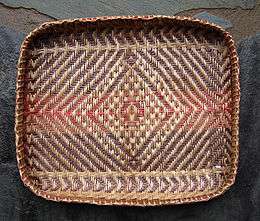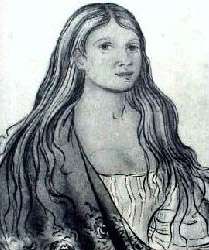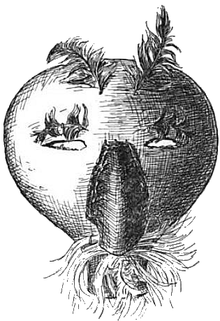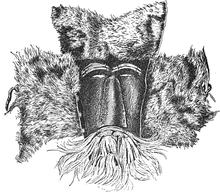Cherokee society
Cherokee society refers to the traditional society and culture of the Cherokee it also refers to a family and a village (or ᎠᏂᏴᏫᏯᎢ (a-ni-yv-wi-ya-i) in Cherokee language) people. The Cherokee are a people native to North America who at the time of European contact in the 17th century inhabited the mountain and inland regions of the southeastern United States in areas of present-day Tennessee, Virginia, North Carolina, South Carolina and Georgia, before the majority of the tribe was forcefully moved to Indian Territory.

Cherokee society was traditionally organized into seven clans, with Cherokee villages having two governmental units (with one government handling affairs in peacetime and the other during times of war) and a medicine chief, who would resolve disputes between the Red Chief and White Chief should they disagree. Family was central to Cherokee society. During the year, the Cherokee celebrated the Cherokee Moons Ceremonies.
The capital of the Cherokee Nation and the United Band of Cherokee Indians, both federally recognized Cherokee tribes, is Tahlequah, Oklahoma. According to local legend, after the arrival of the Cherokee on the Trail of Tears, three tribal elders had scheduled a rendezvous near present-day Tahlequah in order to select a site to settle and use as the seat of tribal government. Two elders arrived and waited for the third. After waiting until dusk they decided "two is enough" (Ta'ligwu). In Cherokee, "Ta'li" represents the number two and "gwu" means "it's enough", or translated as "Two is enough". This legend purportedly began in the 1930's. A more likely origin comes from the ancient eastern Cherokee town of Great Tellico, spelled Talikwa in Cherokee. Still others trace it to the word tel-i-quah which is interpreted "plains" though there is no specific word for "plains" in the Cherokee lexicon.[1]
The third federally recognized Cherokee tribe is the Eastern Band of Cherokee Indians, whose headquarters are in the town of Cherokee, North Carolina in the Qualla Boundary, south of the Great Smoky Mountains National Park. They are primarily the descendants of those persons listed on the Baker Rolls of Cherokee Indians.
The Seven Cherokee Clans
Ancient Cherokee or Ah-ni-yv-wi-ya society was traditionally grouped around a social organization of seven clans. These were:
- Blue (also Panther or Wild Cat) Clan (ᎠᏂᏌᎰᏂ (a-ni-sa-ho-ni) in Cherokee) made a medicine from a bluish colored plant called the Cherokee black drink for purification ceremonies.
- Long Hair (also Twister, Hair Hanging Down, or Wind) Clan (ᎠᏂᎩᎶᎯ (ah-ni-gi-lo-hi) in Cherokee) wore their hair in elaborate hairdos, walked in a proud and vain manner twisting their shoulders.[2] The Peace Chief was usually from this clan.
- Bird Clan (ᎠᏂᏥᏍᏆ (a-ni-tsi-s-qua) in Cherokee) were the keepers of the birds, skilled in using blowguns and snares for bird hunting.
- Paint Clan (ᎠᏂᏬᏗ (a-ni-wo-di) in Cherokee) made red paint and gathered the sacred colors used in the ceremonies.
- Deer Clan (ᎠᏂᎠᏫ (a-ni-a-wi) in Cherokee) were the keepers of the deer and were known as fast runners and deer hunters.
- Wild Potato (also Bear, Raccoon, or Blind Savannah) Clan (ᎠᏂᎦᏙᎨᏫ (a-ni-ga-do-ge-wi) in Cherokee) gathered the wild potato in swamps along streams for food.
- Wolf Clan (ᎠᏂᏩᏯ (a-ni-wa-ya) in Cherokee) was the largest and most prominent clan providing most of the tribe's war chiefs. They were keepers of the wolf and the only clan who could kill a wolf.
The clan provided many important functions including care for orphans and the destitute, and hospitality for visiting clan members from other towns. This practice was referred to as Gadugi in ancient times.[3]
Villages/Government

Each village of the Cherokees had two governmental units: a white and red government. During times of peace the white government had complete control of all affairs dealing with the village. This government consisted of older and wiser men and women who would not make foolish decisions. In times of war all duties fell on the red government which consisted of younger men who would do well in battle.[4]
White government
The white government consisted of the Peace Chief or "Beloved Man", an advisor, prime counselors (one from each clan unit), a council of elders, a chief speaker, messengers and ceremonial officers. This is the organization that made the decisions which affected the tribe during their times of peace including domestic issues and ceremonies.[5][6]
Red government
The red government consisted of a Great War Chief, The Great War Chief's Second, seven War Counselors, a War Woman or "Beloved Woman", the Chief War Speaker, Messengers, Ceremonial Officers and War Scouts. The seven war counselors were in charge of declaring war when they felt the circumstances made it necessary. The War Woman and Grandmother Elders would declare the fate of captives and prisoners taken in times of war.[7][8]
The Council House
The Cherokee towns had a large meeting house called a Council House. The Council House was the center of government for each town and had seven-sides which provided seven sections of seats that gave each clan a section for its representatives within the governmental structure. The seven sections of seats surrounded the sacred fire. Weddings and other meetings were also held within the Council House.[9]
The Beloved Women

The Beloved Women (Ghigau (ᎩᎦᎤ) or Agigaue (ᎠᎩᎦᎤᎡ)), also known as "War-women", were chosen by each clan for their bravery in battle and outstanding qualities like honesty and wisdom. They led the Council of Women and held a voting seat in the Council of Chiefs. She was given the responsibility of deciding the fate of prisoners. She also had the right to be the sage and guide of her people often believed to be spoken to by the Great Spirit.[10] Another of the duties of a Beloved Woman was as ambassador and peace negotiator. An even greater title was Chigau (ᏥᎦᎤ) meaning "greatly beloved woman"[11]
Family
The Cherokee had a matrilineal society, a social system in which their descent was traced strictly through their mother's side of the family. The most important man in the life of any Cherokee child was their mother's brother. Discipline and instruction in hunting and warfare rested not with the child's father, but with his maternal uncle.
Marriage
Because a child belonged to his mother's clan he/she were not allowed to marry into their own clan.[12] Neither were they allowed to marry into their fathers clan. Cherokee rarely married a second time because the only honorable second marriage would be for a widow to marry her deceased husband's brother.
When a man wished to court a woman (age of consent typically being past puberty or about 15 for girls, 17 for boys) he would bring an offering of deer meat to the her clan as a symbol of his ability to care for her. She could then refuse or accept the offering. A Cherokee male typically courted one woman at a time. There are examples of polygamist marriage and same sex co-habitation in the ancient culture but they are extremely rare. If she accepted, the courtship would then require the approval of both of the clans and by a Clan Grandmother.[13]
Once a couple had married the man moved in with his wife near his wife's clan. Since the children of a Cherokee marriage belonged to the mother's clan her male relatives (brothers, uncles, and older cousins) were responsible for the cultural and social development of any male children and the other female relatives (sister's, aunts, and grandmothers) were responsible for the cultural and social development of any female children.
Divorce
If a man failed to provide, was unfaithful, or disgraced his wife's clan, the wife could divorce her husband by placing his belongings outside the opening of their dwelling, but could not divorce him for frivolous reasons and typically required clan approval. The man went back to live with his clan and may not have been able to marry again depending on the reason for divorce and whether a clan would deem him acceptable. In a traditional Cherokee household, the woman owned the property, dwellings, furnishings, and any children therefore they would continue to live with their mother and her clan.[14]
Naming
Between four to seven days after the birth of a baby, a name would be chosen by an elder in the family, usually from their father's clan. The baby would be taken by a priest/Medicine Man and waved four times over a fire while a prayer was said. The naming ceremony traditionally took place within seven days of the birth and was done in a place of running water where the body was immersed in the water seven times.
A baby’s name was subject to change later in its life, if it earned a new name through an outstanding act or a great accomplishment, or after passing puberty when they could decide on a name for themselves. Cherokee are not fixated on having their birth name all their life which confused many Europeans. The naming gave the ability to evolve and change as their identity changed with experience and growth.[15][16]
Blood revenge
The blood revenge custom, an ancient Ah-ni-ku-ta-ni belief, was usually carried out by an older male of the victim's clan if it could not be undertaken by his oldest brother. The Cherokee believed that balance had to be restored in order to preserve the balance of forces between the two worlds, the spirit world, and the world of physical reality. Blood revenge was to free the soul of the victim and to let it pass from this world to the next. (It was the practice to avenge the victim by taking the life of the murderer himself, however, a close relative of the murderer would satisfy the revenge.) The Cherokee had four towns of refuge, one of them was Echota, to protect anyone who intentionally or unintentionally killed another Cherokee. A priest's property was considered a place of refuge as well, and the avenger could not harm the presumed murderer there. The Ancient Law of Blood Revenge was reformed by the Cherokee Tribal Council on September 11, 1808 and subsequently abolished in 1810. This act of abolishment was seen to have advanced the Cherokees in civilization, and it was universally accepted by the Cherokee People. The reformation in 1808 created the Lighthorsemen as the chief law enforcement of the Nation until it was reformed in 1817. By 1825 the Lighthorseman were replaced by Marshals, Sheriffs and Constables as a demand for more rigid law enforcement.[17][18]
Ceremonies
Prior to the Removal, the Cherokee had an agriculturally based civilization. Their ceremonies centered around their agricultural seasons, such as the first green grass or the first harvest of green corn. There were seven primary ceremonies celebrated by the Cherokee but smaller subsequent ceremonies and or extension of primary ceremonies existed. Ceremonies could last days or even weeks. The seven are as follows: New Moon Festival (First Festival), Green Corn Ceremony (Second Festival), Ripe Corn Ceremony (Third Festival), Great New Moon Ceremony (Fourth Festival), Friends Made Ceremony (Fifth Festival also known as Propitiation Festival), Bounding Bush Ceremony (Sixth Festival) and the Uku or Ookah Dance(Only performed every 7 years).[19]
Traditional use of masks

The Cherokee used masks in numerous dances. One such dance, known as "The Booger Dance", was usually performed in the late fall or winter. The Booger masks were made to represent the faces of Indian tribes who were the enemies of the Cherokee. After the arrival of Europeans, Booger Masks were made featuring large eyebrows, mustaches, beards, and bald heads, similar to the appearance of Europeans.

The Booger Masks were made from large gourds, hornets nests, buckeye, or poplar wood. Booger Masks have been mass-produced and sold to tourists in Cherokee, North Carolina.
The Bear Dance, Beaver Dance, and Forest Buffalo Dances also employed masks. Buffalo masks were typically fashioned from Buckeye wood. Both Bear and Beaver masks were made from the fur hides of each animal and were worn loosely or sewn.
See also
- Cherokee mythology
- Green Corn Ceremony
- Unto These Hills
- Ani-kutani
- Stomp Dance
- Wild onion festival
Footnotes
- About Tahlequah
- Cherokee,NC
- "Tradition: Gadugi | Periscope". www.knowitall.org. Retrieved 17 August 2020.
- "Cherokee Lifestyles and Town Structure - Ninety Six National Historic Site". U.S. National Park Service. 9 August 2012. Retrieved 17 August 2020.
- White Government
- Cherokee Government
- Red Government
- Cherokee Government
- Council House
- Ghigau
- Chigau
- Mothers Clan
- Cherokee Courtship
- Divorce
- Cherokee Names
- The Cherokee People: The Story of the Cherokees from Earliest Origins to Contemporary Times by Thomas E Mails,Pg 72
- Blood Revenge
- Lighthorsemen
- Smithsonian Institution, Bureau of American Ethnology Bulletin 133 The Eastern Cherokee by William Harlen Gilbert, Jr.
References
- Garrett, J.T. and Michael Tlansusta. The Cherokee Full Circle. Bear & Company. ISBN 1-879181-95-9.
- Reed, Marcelina. Seven Clans of the Cherokee Society. Cherokee Publications. First Edition, ISBN 0-935741-17-8.
- Mails, Thomas E. The Cherokee People:... Council Oak Books ISBN 9780933031463
External links
- Official Site of the Cherokee Nation
- [indians.org Official site for American Indian information]